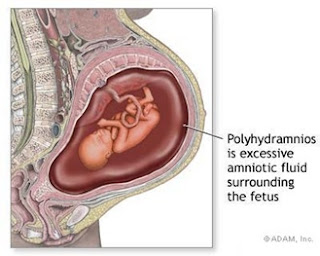Oligohydramnios
§ Severe reduction of amniotic fluid volume (typically less than 500 ml at term); highly concentrated urine.
§ Possibility of prolonged, dysfunctional labor (usually beginning before term).
§ Fetal risk: renal anomalies, pulmonary hyperplasia, hypoxia, increased skeletal deformities, and wrinkled, leathery skin.
Causes
§ Exact cause is unknown.
§ Any condition that prevents the fetus from making urine or that blocks urine from going into the amniotic sac.
§ Contributing factors: uteroplacental insufficiency, premature rupture of membranes prior to labor onset, maternal hypertension, maternal diabetes, intrauterine growth restriction, postterm pregnancy, fetal renal genesis, polycystic kidneys, and urinary tract obstructions.
Assessment
§ Asymptomatic
§ Lagging fundal height growth.
Test result
§ Ultrasonography reveals no pockets of amniotic fluid larger than 1 cm.
Treatment
§ Close medical supervision of the mother and fetus.
§ Fetal monitoring
§ Amnioinfusion (infusion of warmed sterile normal saline or lactated Ringer’s solution) to treat or prevent variable decelerations during labor.
Nursing Interventions
1. Monitor maternal and fetal status closely, including vital signs and fetal heart rate patterns.
2. Monitor maternal weight gain pattern, notifying the health care provider if weight loss occurs.
3. Provide emotional support before, during, and after ultrasonography.
4. Inform the patient about coping measures if fetal anomalies are suspected.
5. Instruct her about signs and symptoms of labor, including those she’ll need to report immediately.
6. Reinforce the need for close supervision and follow up.
7. Assist with amnioinfusion as indicated.
8. Encourage the patient to lie on her left side.
9. Ensure that amnioinfusion solution is warmed to body temperature.
10. Continuously monitor maternal vital signs and fetal heart rate during the amnioinfusion procedure.
11. Note the development of any uterine contractions, notify the health care provider, and continue to monitor closely.
12. Maintain strict sterile technique during amnioinfusion.
